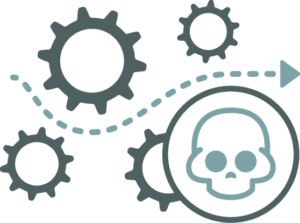 As Halloween approaches, I can’t help but reflect on some of the scary things I’ve encountered in my career as a marketing professional. Perhaps the most terrifying occurred in my role as VP of Marketing for an online printer. We’d been digging into our key metrics and uncovered a significant drop in customer retention, as well as a marked increase in “one and done” customers – those that made a first purchase and never returned. I knew we needed to dive deep into the customer experience to uncover the cause, but I was petrified to tiptoe down into that basement.
As Halloween approaches, I can’t help but reflect on some of the scary things I’ve encountered in my career as a marketing professional. Perhaps the most terrifying occurred in my role as VP of Marketing for an online printer. We’d been digging into our key metrics and uncovered a significant drop in customer retention, as well as a marked increase in “one and done” customers – those that made a first purchase and never returned. I knew we needed to dive deep into the customer experience to uncover the cause, but I was petrified to tiptoe down into that basement.
Why was I scared to dig into the customer experience? You ask. Well, I had more than a few phobias:
- Skeletons in the closet – What were we going to find when we exhumed the body? Would we be overwhelmed by issues related to our legacy systems? Discover a fundamental flaw in our pricing model? Uncover a new competitor that was sucking our blood?
- Monstrous scope – What if the problem was huge? Were we going to have to derail all of our other projects for the year, just to stop the bleeding?
- Terrifying timelines – How long would it take to turn things around? Would I be able to see a positive change soon enough?
- Bottomless pit – Would I have the resources to fix any problems we uncovered?
Well, I decided to face my fears, and bite the bullet. There was no time to waste, as whatever the problem was clearly wasn’t going to fix itself. Here’s how we approached the problem:
1. Map out the Customer Journey
Although we thought we understood what our customers were going through, we took the time to do a deep dive into the data and documented all of the customer touch points. This is a time consuming process, but is simply invaluable in uncovering points along the way that are broken, or just not as good as they should be. We took a good hard look at how, when, where and why customers were engaging with us in the customer journey, and what the customer was thinking, feeling, and doing throughout the process. This enabled us to determine the critical steps in the path to purchase, and all of the key moments leading up to that point where the experience needed to be improved. We also looked at variations of the customer journey by key segment, to understand all the nuances for each segment. From here we were able to identify the path from “current state” to “to be” – the ideal journey for a customer.
2. Created a roadmap with short, medium, and long term projects
Rather than try to make a single, gigantic change, we identified projects that we could tackle in the short, medium, and long term. This enabled us to start to see improvement very quickly, which generated excitement and energy at all levels of the organization. This allowed us to get incremental funding for longer term projects.
3. Developed new contact strategies for each segment
Based on our findings, we were able to develop segment specific contact and communication strategies for each segment. This ensured that we would now reach customers when they needed to be reached, with the message and information that was compelling and relevant.
4. Revamped our email program
Based on our new contact strategies, we knew we needed a more robust email solution, so after a quick evaluation we implemented an enterprise system that provided the ability to automate campaigns based on customer segment, purchase history and frequency, as well as website visits and behavior.
5. Restructured the customer service team
Through our analysis, we determined that we could much better service customers calling into our call center with two levels of support – level 1 (for simple, quick queries) and level 2 (for more complex, time consuming questions). We then trained and staffed the team accordingly, to ensure customers had a consistently high quality of service. And, we created a new IVR phone queue to ensure customers got to the right rep as quickly as possible.
Results
The results of this effort made me want to scream (in a good way):
Within 3 months, our email open rates had increased from 8% to 11%, as a result of the more targeted and relevant email communication strategy.
Within 6 months, the average handle time in our call center had decreased by 20%, due to the new call queue and phone rep structure. In addition, turnover in the call center dropped significantly.
Within a year, our monthly email campaigns had increased from 20 to 34 (significantly more touches, but with more relevant content) and email revenue had grown 40% over the prior year, all with a less than 0.5% opt out rate.
In conclusion
I now know there’s nothing scary about digging into customer experience. No matter how many cobwebs, ghosts and skeletons exist in your business, they are no match for a methodical review of the customer journey. Armed with the information about your current state, you can vanquish the ghouls in an incremental way, to ensure early success in the short term, and even bigger wins down the road.
Share this Post
